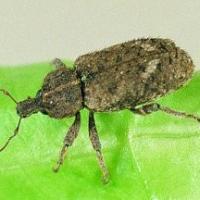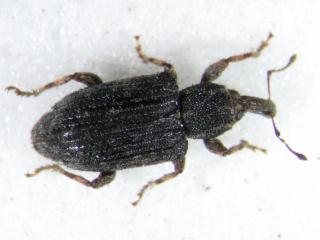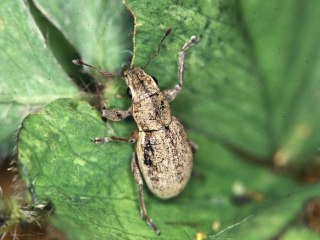Identifying and managing weevils in canola
- Mingenew
- Wandering
- South Stirlings
- Ongerup
- Gairdner
- Gnowellen
Geoff Fosbery (ConsultAg) reports that weevils are causing widespread damage to a seedling canola crop north of Mingenew. The identity of the weevils is unknown and samples are being sent to DPIRD entomologists for identification. A nearby property was inspected by Nick Eyres (Elders) who found similar damage caused by weevils. The weevils had survived insecticides that was applied post sowing and emerged to feed on the canola, causing high levels of damage, in some cases. Images sent in resemble a weevil previously reported from crops between Dongara and Mingenew, which entomologist Andras Szito (DPIRD) believes is a species new to science. This was confirmed when samples were sent to a museum in Europe.
Agworld users have found vegetable weevils in canola near Wandering and weevils in canola at Gnowellen.
Brent Pritchard (Farmanco) found desiantha weevil at densities of 15 per square metre in a seedling canola paddock at South Stirlings . The paddock had received a spray application of bifenthrin at 200 mL/ha prior to seeding. Poor spray coverage is suspected to be the reason behind their survival rather than resistance. The desiantha weevils were causing minor damage to the canola and will be monitored. Brent also reports finding desiantha weevils causing patches of minor damage in canola at Ongerup and Gairdner.
Three species of weevils typically damage canola: vegetable weevil, desiantha (spotted vegetable) weevil, and small lucerne weevil.
Identifying canola weevils
Vegetable weevils are about 10mm long with two short white stripes at an angle on each side of its abdomen. They prefer broadleaved plants, especially capeweed. They are often camouflaged amongst stubble and trash and tend to hide during the day.
Desiantha weevil adults are mottled grey-black in colour with grey flecks on the abdomen, and have the typical elongated weevil snout. They grow up to 7mm long and are flightless. Larvae are white, legless grubs with orange-brown heads, and grow to 8mm in length. Adults chew cotyledons, leaves and stems of canola plants, and may eat small plants down to ground level.
Adult small lucerne weevils are about 5mm long, light grey in colour with a white stripe on each side.
Adult vegetable weevils often harbour in rock heaps and remnant bush areas, and move into the adjoining canola crop from these refuges. The other two weevils have been known to cause damage across the whole paddock.
Weevils can be very hard to find as they hide and play dead with their legs tucked, which helps them blend in with their surroundings. Pitfall traps placed into the ground can be an effective way to find weevils.
If you are unsure of the type of weevil you have found in your canola crop use the PestFax Reporter app to request an identification by our entomologists.
Diagnosing weevil damage
Weevils chew off parts of leaves and cotyledons, giving them a serrated appearance and can eat plants down to ground level at high numbers.
Sometimes crop damage is restricted to paddock edges or where capeweed was in abundance the previous year.
Managing canola weevils
Weevils can be a frustrating pest as they can survive spray applications of insecticides at registered rates due to their behaviour of hiding during the day. For this reason, it can be more effective to spray in the evening when weevils are active.
For insecticide recommendations on managing vegetable weevils in canola, refer to DPIRD’s 2021 autumn winter insecticide spray guide. The vegetable weevil requires higher rates of insecticides than most pests of canola.
For more information on weevils visit DPIRD's Diagnosing weevils in canola page.
For more information contact research scientist Svetlana Micic, Albany on +61 (0)8 9892 8591.
Article authors: Cindy Webster (DPIRD Narrogin) and Svetlana Micic (DPIRD Albany).



